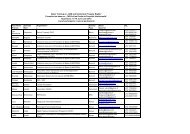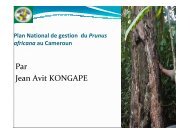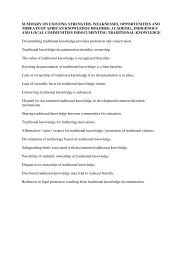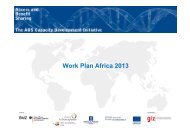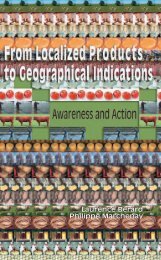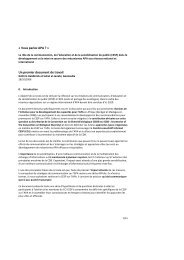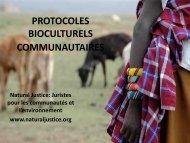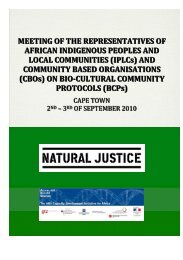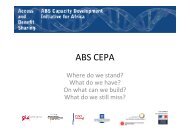The History of Farmers' Rights - Fridtjof Nansens Institutt
The History of Farmers' Rights - Fridtjof Nansens Institutt
The History of Farmers' Rights - Fridtjof Nansens Institutt
You also want an ePaper? Increase the reach of your titles
YUMPU automatically turns print PDFs into web optimized ePapers that Google loves.
4 Regine Andersen<br />
However, the Commission noted that 74 <strong>of</strong> the 156 FAO member nations<br />
had expressed support for the Undertaking; further, that several countries<br />
had indicated that they were not in a position to adhere to the agreement,<br />
or that they lacked the means to give effect to the commitments contained<br />
therein (paragraphs 7, 10 and 11). Urging these countries to respond positively,<br />
even though they might not manage to comply with all provisions<br />
<strong>of</strong> this non-binding agreement, the Commission considered the suggestion<br />
from some members that the text <strong>of</strong> the Undertaking should be<br />
modified (paragraphs 12 and 13). It recommended that the Secretariat<br />
prepare a paper, for consideration by the Commission at its next session,<br />
analysing countries’ reservations to the Undertaking and delineating possible<br />
courses <strong>of</strong> action, including suggestions for possible interpretations<br />
<strong>of</strong> the text to increase acceptance <strong>of</strong> the Undertaking (paragraph 13).<br />
<strong>The</strong> Commission also established a Working Group, chaired by its<br />
Chairman and consisting <strong>of</strong> 23 members from different country groups, to<br />
consider the progress made in implementing the Commission’s proramme<br />
<strong>of</strong> work and any other matters referred to it by the Commission (pararaphs<br />
78–80). It was in this Working Group that farmers’ rights were first<br />
addressed in the FAO system, but that did not come until 1986.<br />
FAO Conference Session, 1985<br />
FAO, 1985: Report <strong>of</strong> the Conference <strong>of</strong> FAO, Twenty-second Session,<br />
Rome, 9–28 November 1985, C 1985/REP.<br />
At the following sessions <strong>of</strong> the FAO Council 9 and Conference in 1985,<br />
implementation <strong>of</strong> the International Undertaking was a subject, but no<br />
mention <strong>of</strong> farmers’ rights as such was documented. <strong>The</strong> rights <strong>of</strong> plant<br />
breeders were, however, explicitly addressed at the Conference Session<br />
(paragraph 291). Due to the low number <strong>of</strong> countries adhering to the<br />
Interational Undertaking, countries were urged to spell out their reservaions<br />
to this non-binding international agreement. Various members indiated<br />
that their national legislation, including plant breeders’ rights, deterined<br />
the degree to which they could adhere to the Undertaking. Several<br />
members were <strong>of</strong> the view that if the Undertaking was modified in this<br />
respect, more countries could adhere to it.<br />
First Meetings <strong>of</strong> the Working Group <strong>of</strong> the Commission on Plant<br />
Genetic Resources, 1986<br />
FAO, 1986: Report <strong>of</strong> the Working Group <strong>of</strong> the FAO Commission on<br />
Plant Genetic Resources, 2–3 June 1986, CPGR/87/3, October 1986.<br />
<strong>The</strong> first time that farmers’ rights were reported as being addressed in an<br />
FAO forum was at the First Meeting <strong>of</strong> the Working Group in Rome, 2–3<br />
9 <strong>The</strong> 49-member Council is the executive organ <strong>of</strong> the Conference. Its powers<br />
are delegated to it by the Conference. <strong>The</strong> Council meets at least four times beween<br />
regular Conference sessions.




